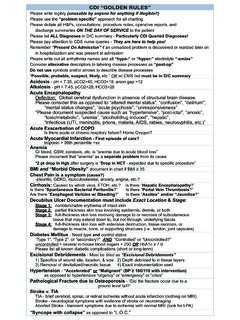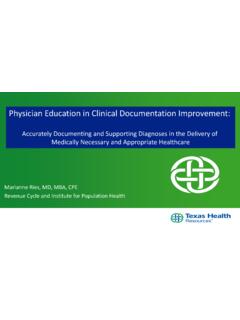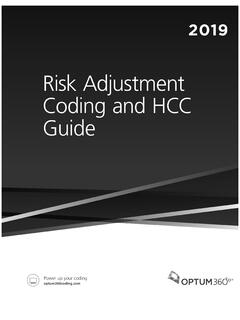Transcription of and Coding of Complications
1 2016 HCPro, a division of BLR. All rights reserved. These materials may not be duplicated without express written S. Gold, MDPresident, DCBA, , GAPresented by Cesar M. Limjoco, MDDocumentation and Coding of Complications2 Learning Objectives At the completion of this educational activity, the learner will be able to: Discuss concepts and reasons for assignment of complication codes Explore the impact of reporting complication codes Analyze the difference between assigning complication codes for money and for accuracy of patient data Describe the importance of utilizing clinical understanding of diseases that may exist contemporaneously with surgery List tips and hints for evaluating your processes and disseminating information to clinicians3 Historical Perspective CC is defined as Complications and comorbidities Grading companies used to lump them all together as Complications (Solucient, AHRQ, Healthgrades, UHC, etc.)
2 The Delta Group listened first! 2005 history at Indiana University Institution of POA 2008 Goal of Coding professionals was to maximize reimbursement from Medicare under DRG system They LOVED to assign complication codes Doctors hated it when they learned 2016 HCPro, a division of BLR. All rights reserved. These materials may not be duplicated without express written We re Talking About Every day CDI specialists and Coding professionals struggle with the question: Is this a complication or an expected outcome of surgery? With an increase in publicly reported physician and hospital data, accurately reporting Complications is vital to the reputations of your surgeons and your facility. Hear from a former surgeon about common stumbling blocks, such as postoperative ileus and accidental punctures and lacerations, with suggestions for That May or May Not Be Ileus Atelectasis Anemia of acute blood loss (ABLA) CAUTI Acute renal failure (ATN or not?)
3 ?) Encephalopathy Cardiogenic shock Wound infection Retained surgical item Iatrogenic pneumothorax Perioperative hemorrhage/hematoma (hematoma/seroma conundrum in ICD 10) Respiratory failure Postoperative sepsis Wound dehiscence Accidental laceration6 Who s Measuring? Hospital Compare Initiatives Patient Assessment Instruments/ AHRQ (PSIs) Joint Commission UHC (University Health System Consortium) for/quality performance Private companies Healthgrades Comparison analytics Crimson/The Advisory Board Leapfrog Consumer Reports US News/Parents magazine 2016 HCPro, a division of BLR. All rights reserved. These materials may not be duplicated without express written )CC or MCC capture may lead to increased reimbursement for hospital billing purposes for PSIs and other Complications or results of careb)At start of DRG system, coders encouraged to identify all CC s so as to maximize Medicare reimbursementc)With conversion to HACs, hospital will have reduced payments with identification of Complications of care , ethical profilesa)Hospital reputation depends on determination of value based servicesb)
4 Hospital and physician reputations will suffer lose market share8 Long Term Effects for Inadequate Homework How doctors and hospitals have collected billions in questionable Medicare fees Center investigation suggests costs from upcoding and other abuses likely top $11 billion Medical billing a target of fraud investigations Upcoding problem contributes to Medicare fraud Kitchen sink Coding . Though technically only confirmed diagnoses can be coded, physicians often throw in other codes, called kitchen sink Coding . Providers may have a poor understanding of Coding guidelines or may be justifying various treatments or exaggerating injuries. This practice can hurt patients in the long run by creating preexisting conditions they may never actually have had. Upcoding can cost you money and your health Learn about this fraudulent practice and help put a stop to it9 Considerations When an Event Is Noted Look for conditions (diseases) that were present on admission, even if inadequately documented Look for conditions caused by the disease itself and not by the surgery Look for conditions caused by some other issue and totally unrelated to the surgery Distinguish events caused by the surgery versus events caused by medications or anesthesia Look for incidental findings when doc states Complications or complicated by Use your clinical acumen and NOT Coding desires, whether you are a coder or nurse!
5 Clinical truth!!! Be sure it meets UHDDS criteria as a valid code! 2016 HCPro, a division of BLR. All rights reserved. These materials may not be duplicated without express written That May or May Not Be Ileus Atelectasis Anemia of acute blood loss (ABLA) CAUTI/VAP/CLABSI Acute renal failure (ATN or not??) Encephalopathy Cardiogenic shock Wound infection Retained surgical item Iatrogenic pneumothorax Perioperative hemorrhage/hematoma (hematoma/seroma conundrum in ICD 10) Respiratory failure Postoperative sepsis Wound dehiscence Accidental laceration11 Ileus Ileus has two models: Obstructive and paralytic Ileus occurs after almost all abdominal surgeries physiologic response all patients treated NPO and then advanced in diet when bowel activity returns Ileus occurs with all patients with abdominal trauma and perforation caused by the trauma or any perforation or infected process that s what causes them to vomit Admission with ileus caused by inflammatory process will have ileus after surgery caused by the same process (pancreatitis, appy, acute GB, Crohn s disease, perforated tic, etc.)
6 Not the surgery Obstructive ileus caused by surgery is due to inadequate surgery or a major vascular event patient returns to OR for surgery Paralytic ileus may be associated with perforation, infection, dead bowel, abscess that was not POA they return to OR or have interventional procedure Paralytic ileus may be due to patient s autonomic neuropathy and not due to the surgery, but delay caused by diabetes or other neuropathy12 Complications That May or May Not Be Ileus Atelectasis Anemia of acute blood loss (ABLA) CAUTI/VAP/CLABSI Acute renal failure (ATN or not??) Encephalopathy Cardiogenic shock Wound infection Retained surgical item Iatrogenic pneumothorax Perioperative hemorrhage/hematoma (hematoma/seroma conundrum in ICD 10) Respiratory failure Postoperative sepsis Wound dehiscence Accidental laceration 2016 HCPro, a division of BLR.
7 All rights reserved. These materials may not be duplicated without express written Atelectasis may exist preop in morbidly obese patients ( obesity hypoventilation syndrome ) or patients with obstructive airway disease (bronchiectasis, cystic fibrosis) or other obstruction (malignancy, foreign body, stricture) All patients after major chest surgery may have atelectasis seen on postop chest film All patients after major chest surgery have incentive spirometry and ambulation or turning or chest PT ordered this is preventative or treatment for incidental finding of atelectasis and does not meet UHDDS criteria as a valid diagnosis When patient requires additional intervention (nasotracheal suctioning, bronchoscopy, drainage of air or fluid collection in chest causing collapse of lung), then it s codable Pneumonia after surgery stated in area of atelectasis is NOT hypostatic pneumonia it s bacterial all Rx with abxAtelectasis14 Complications That May or May Not Be Ileus Atelectasis Anemia of acute blood loss (ABLA) CAUTI/VAP/CLABSI Acute renal failure (ATN or not?)
8 ?) Encephalopathy Cardiogenic shock Wound infection Retained surgical item Iatrogenic pneumothorax Perioperative hemorrhage/hematoma (hematoma/seroma conundrum in ICD 10) Respiratory failure Postoperative sepsis Wound dehiscence Accidental laceration15 ABLA BLA BLA First of all, make sure it s anemia and not lower Hb that does not represent anemia Significant drop in hemoglobin is an outpatient term, a bogus code in the hospital code the cause!!! Patients may come in for elective or emergency surgery with preexisting anemia of various causes Anemia of CKD, sickle cell anemia, iron deficiency anemia Often you will see low hemoglobin to begin with and minimal blood loss leading to low postop hemoglobin was the anemia or transfusions caused by the surgery when 50 cc EBL? Too many times patient receives 3,000 cc crystalloid and has minimal blood loss, but HB after surgery is significantly lower due to hemodilution 2016 HCPro, a division of BLR.
9 All rights reserved. These materials may not be duplicated without express written Between Complication PSI 9 and Event Hemorrhagic complication of a procedure implies that there was unexpected bleeding during or after the invasive procedure Significant bleed may have led to the need for the procedure: Ruptured aortic aneurysm. Bleeding esophageal varices or diverticulum or angiodysplasia. Multiple trauma with fractures, ruptured spleen, liver, laceration of omentum. These patients may not be seen to have anemia until resuscitation or after the operative procedure. WHY??? Entering belly or chest involves cutting and controlling bleeding on the way in17 Half Full or Half Empty? 9 Is Postoperative Hemorrhage or Hematoma vs. Intraoperative PSI 9 reporting limited to return to procedure room for control of bleed or for drainage of a hematoma Exclude cases: With principal diagnosis of postoperative hemorrhage or postoperative hematoma or secondary diagnosis present on admission Where the only operating room procedure is postoperative control of hemorrhage or drainage of hematoma Where a procedure for postoperative control of hemorrhage or drainage of hematoma occurs before the first operating room procedure Note: If day of procedure is not available in the input data file, the rate may be slightly lower than if the information was available MDC 14 (pregnancy, childbirth, and puerperium) 2016 HCPro, a division of BLR.
10 All rights reserved. These materials may not be duplicated without express written Postprocedural hemorrhage and hematoma of the spleen following a procedure on the hemorrhage and hematoma of the spleen following other hemorrhage and hematoma of an endocrine system organ or structure following an endocrine system hemorrhage and hematoma of an endocrine system organ or structure following other hemorrhage and hematoma of a nervous system organ or structure following a nervous system hemorrhage and hematoma of a nervous system organ or structure following other hemorrhage and hematoma of right eye and adnexa following an ophthalmic hemorrhage and hematoma of left eye and adnexa following an ophthalmic Postprocedural hemorrhage and hematoma of eye and adnexa following an ophthalmic procedure, bilateral20 ICD 10 Error to Be Dealt With A seroma is a clear fluid collection usually due to the process operated on or due to accumulation of serous fluid a traumatic seroma is caused by tissue damage from the injury A hematoma is a blood collection usually related to excessive bleeding at the site, either from the original process or due to excessive bleeding a traumatic hematoma is caused by tissue damage from the injury A hemorrhage is significant bleeding it may or may not lead to hematoma THESE ARE NOT THE SAME NOR DO THEY HAVE THE SAME ORIGINS AND SHOULD NOT BE THE SAME CODE21 Bad Coding AdvicePostoperative SeromaCoding Clinic, First Quarter 2014 Page: 7 Coding advice or code assignments contained in this issue effective with discharges March 31.















